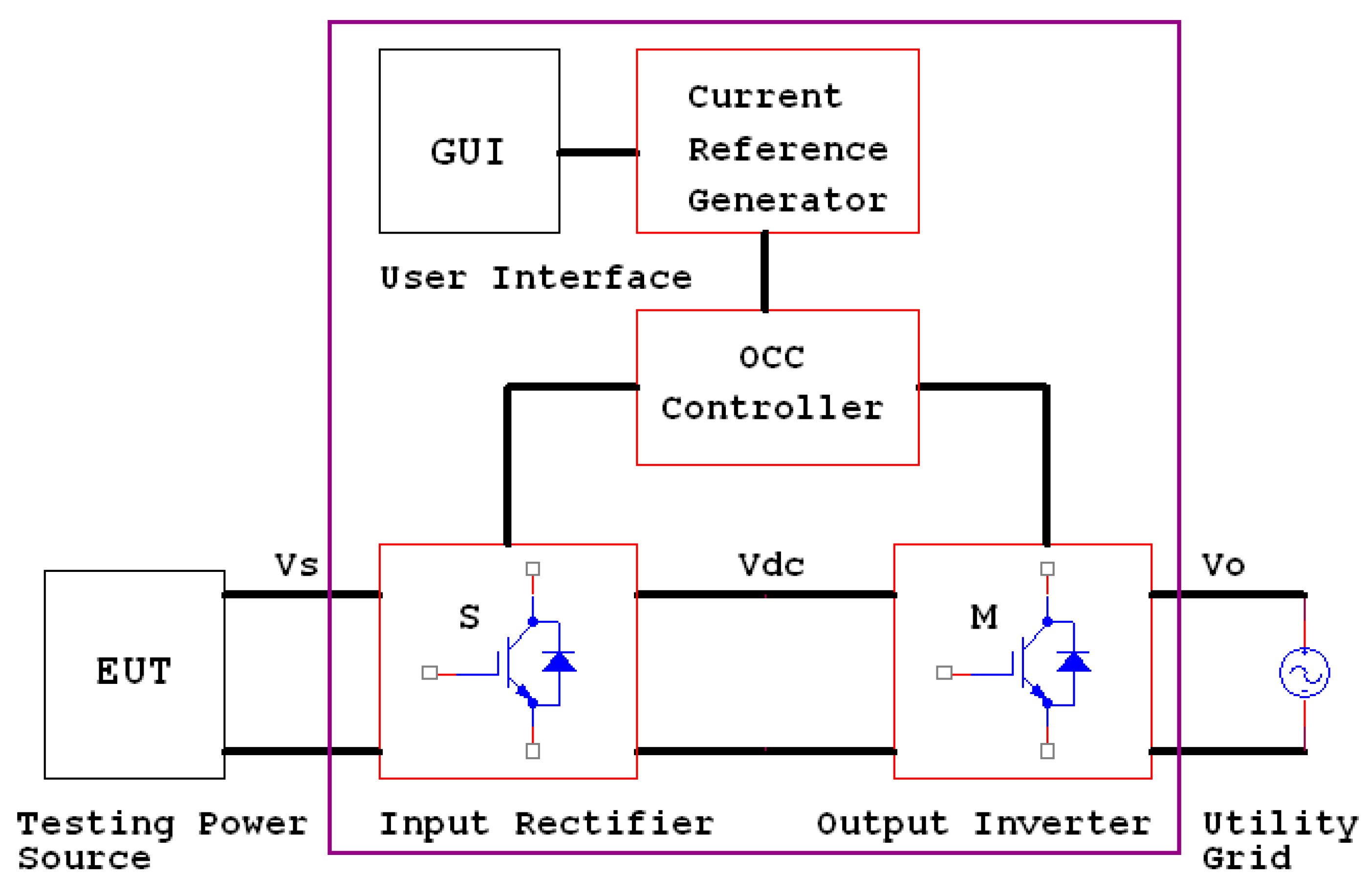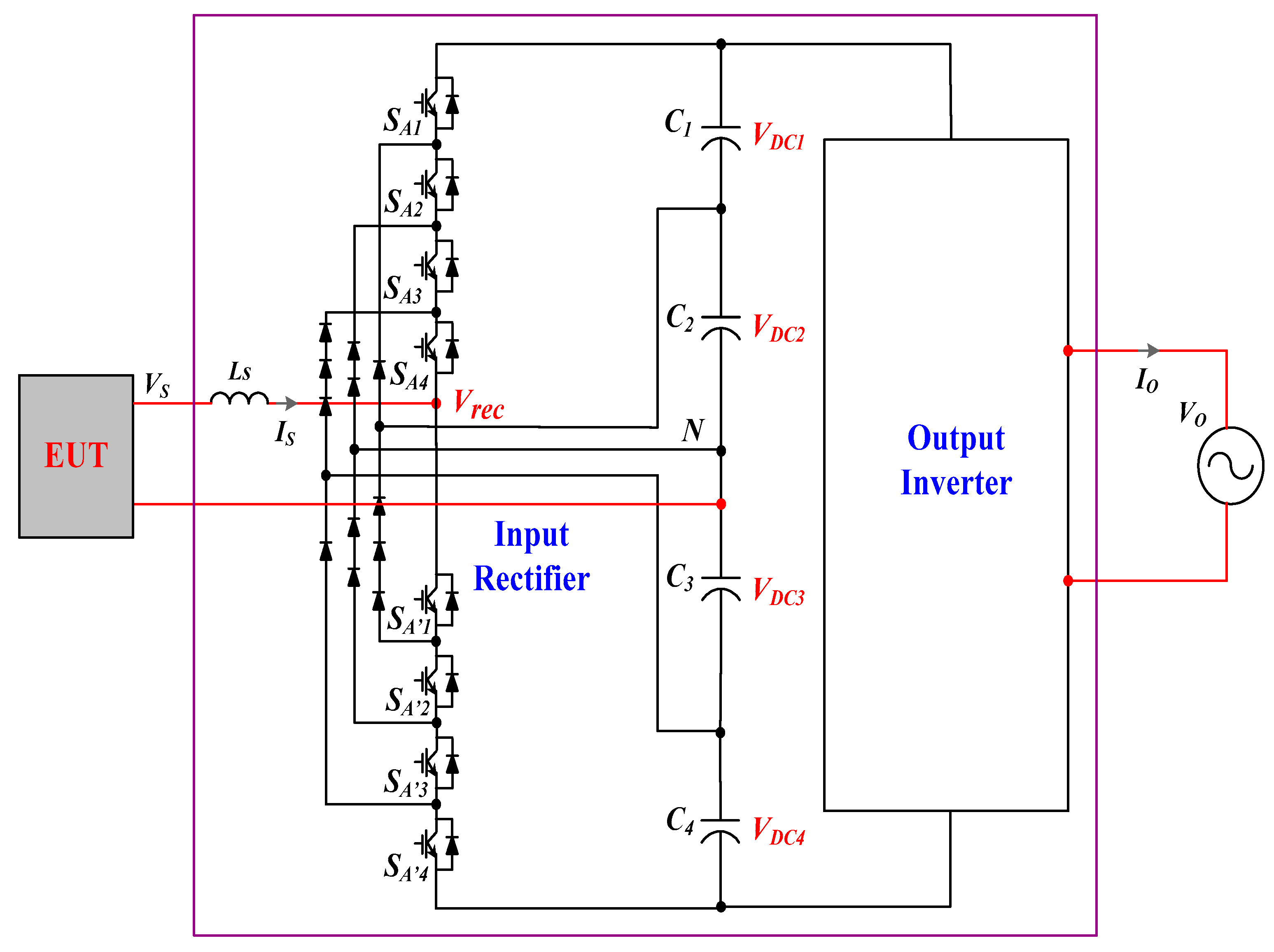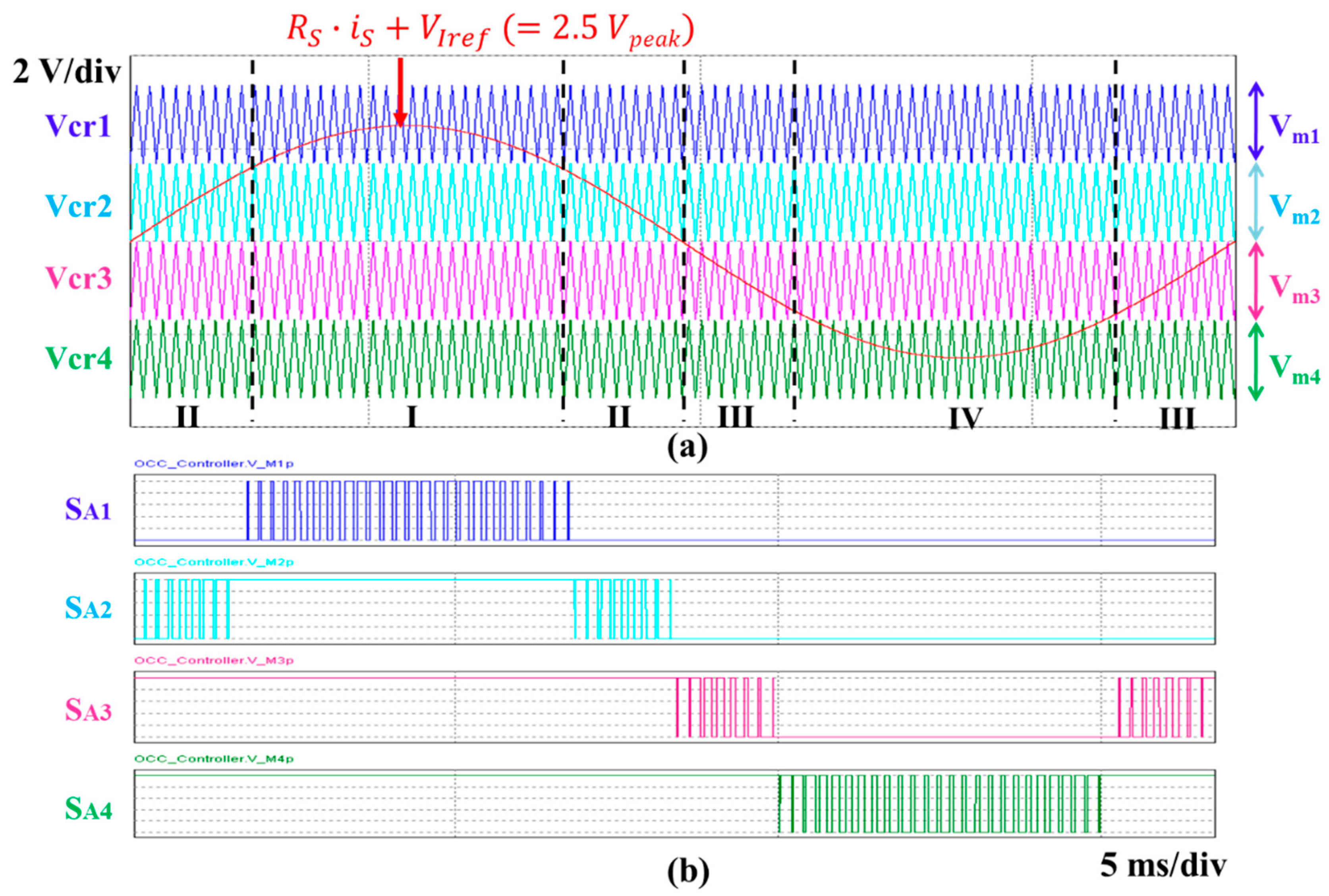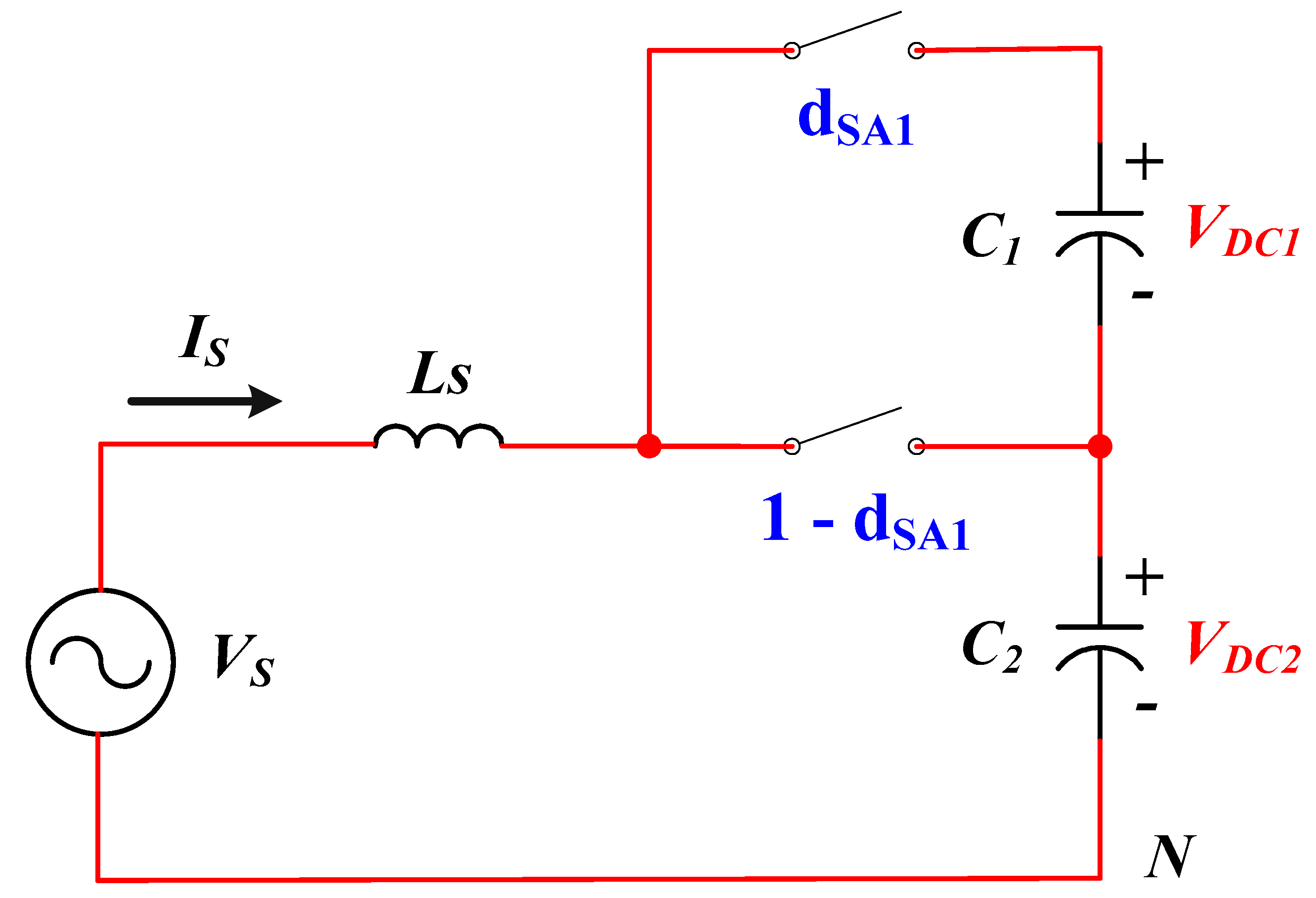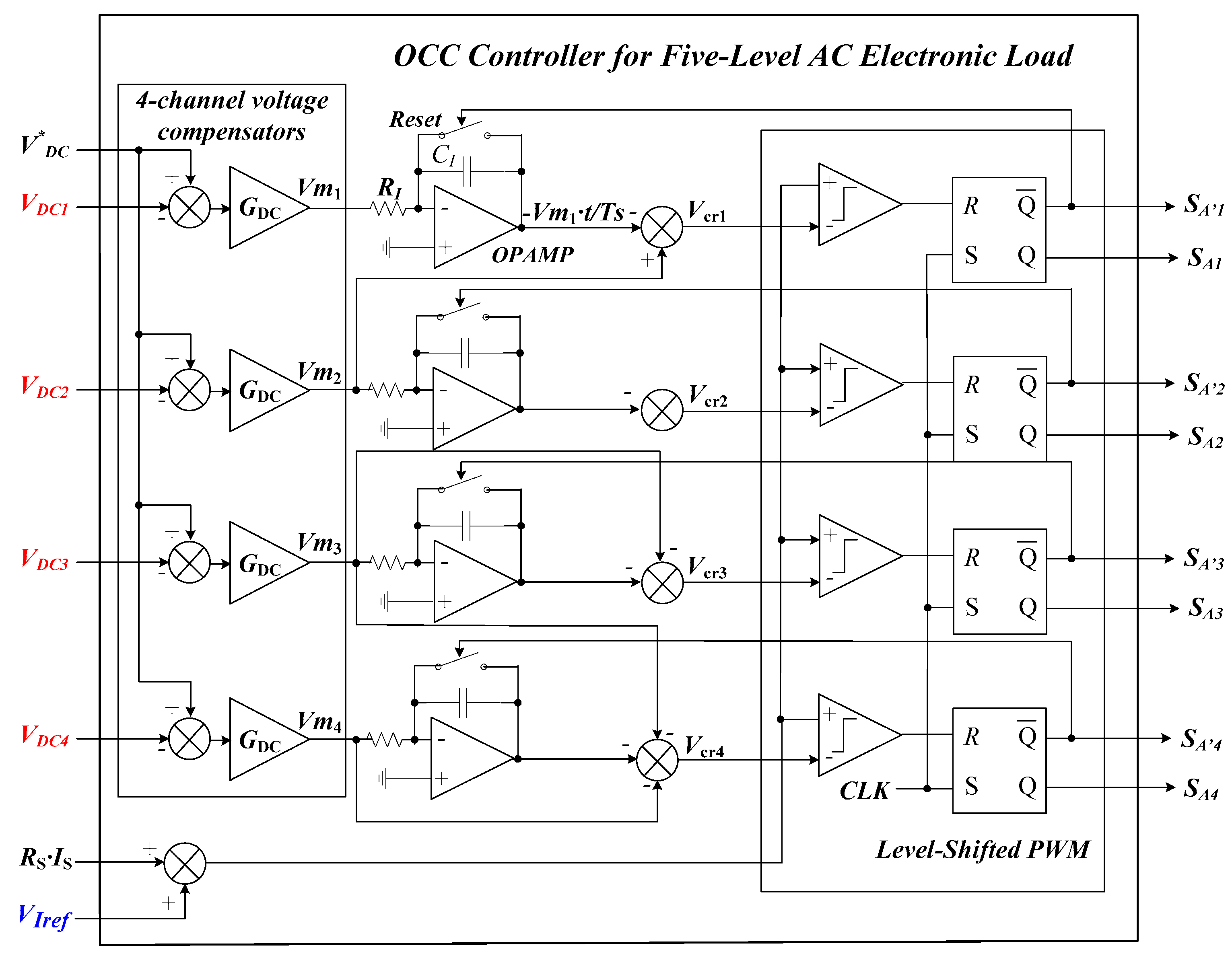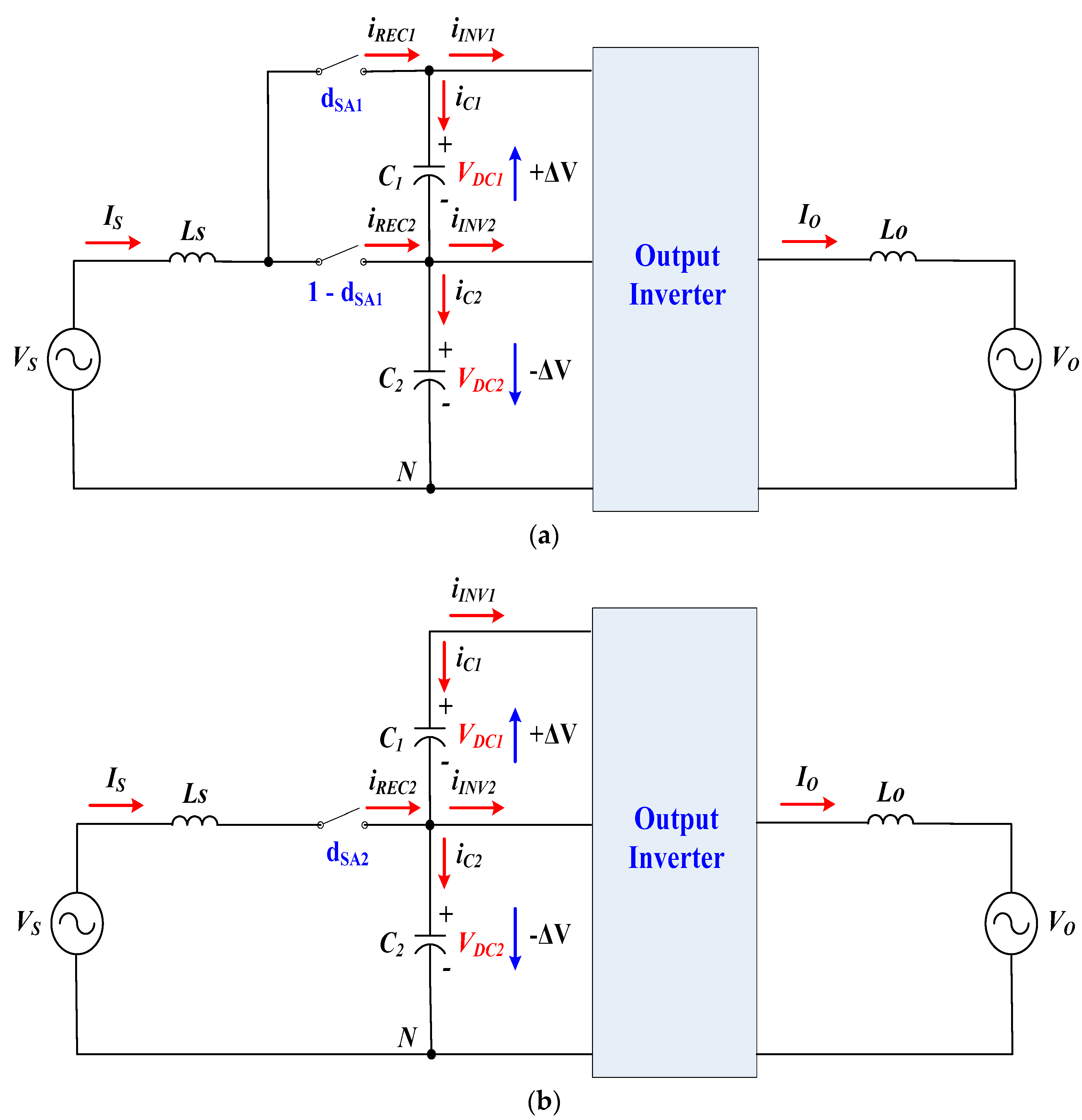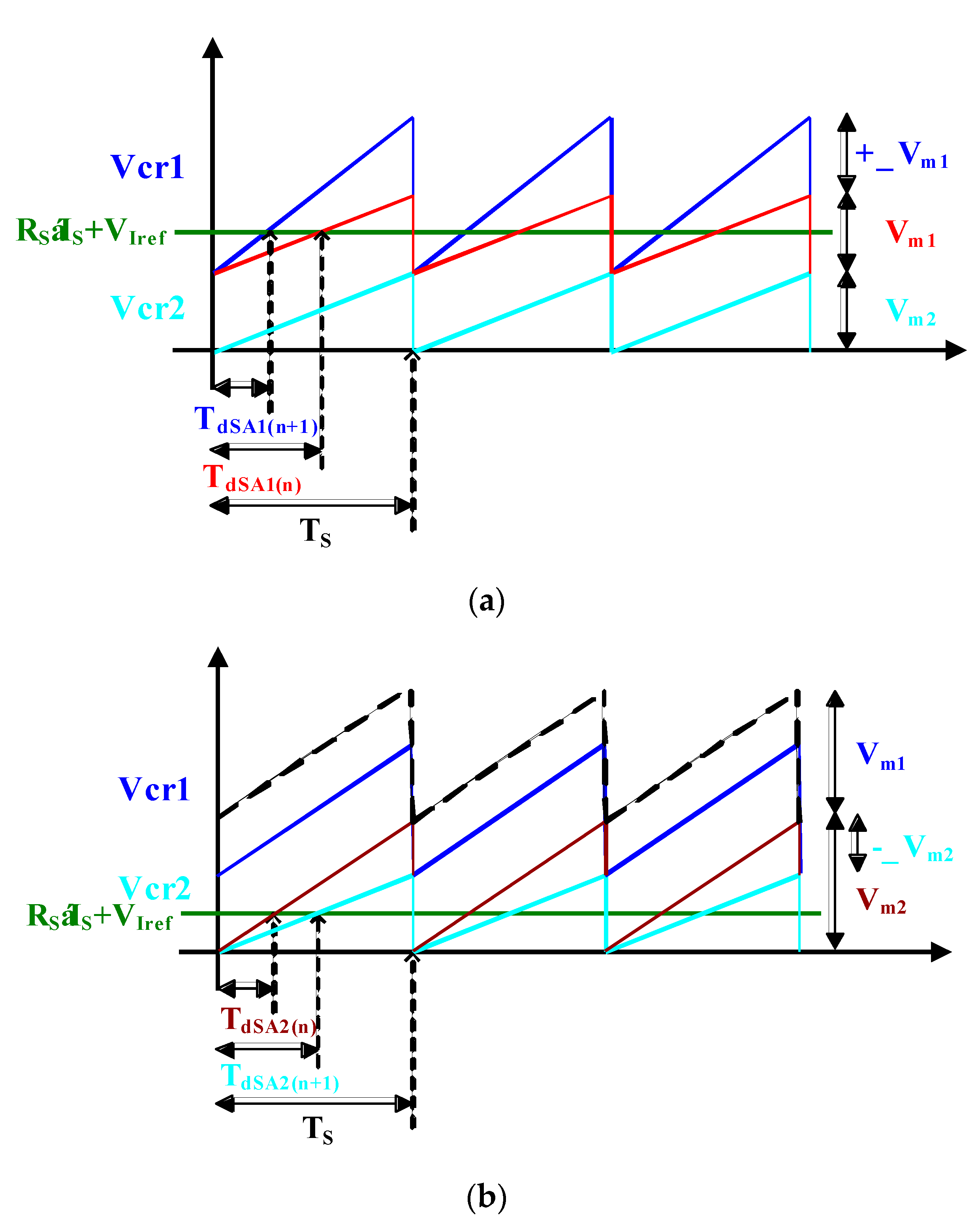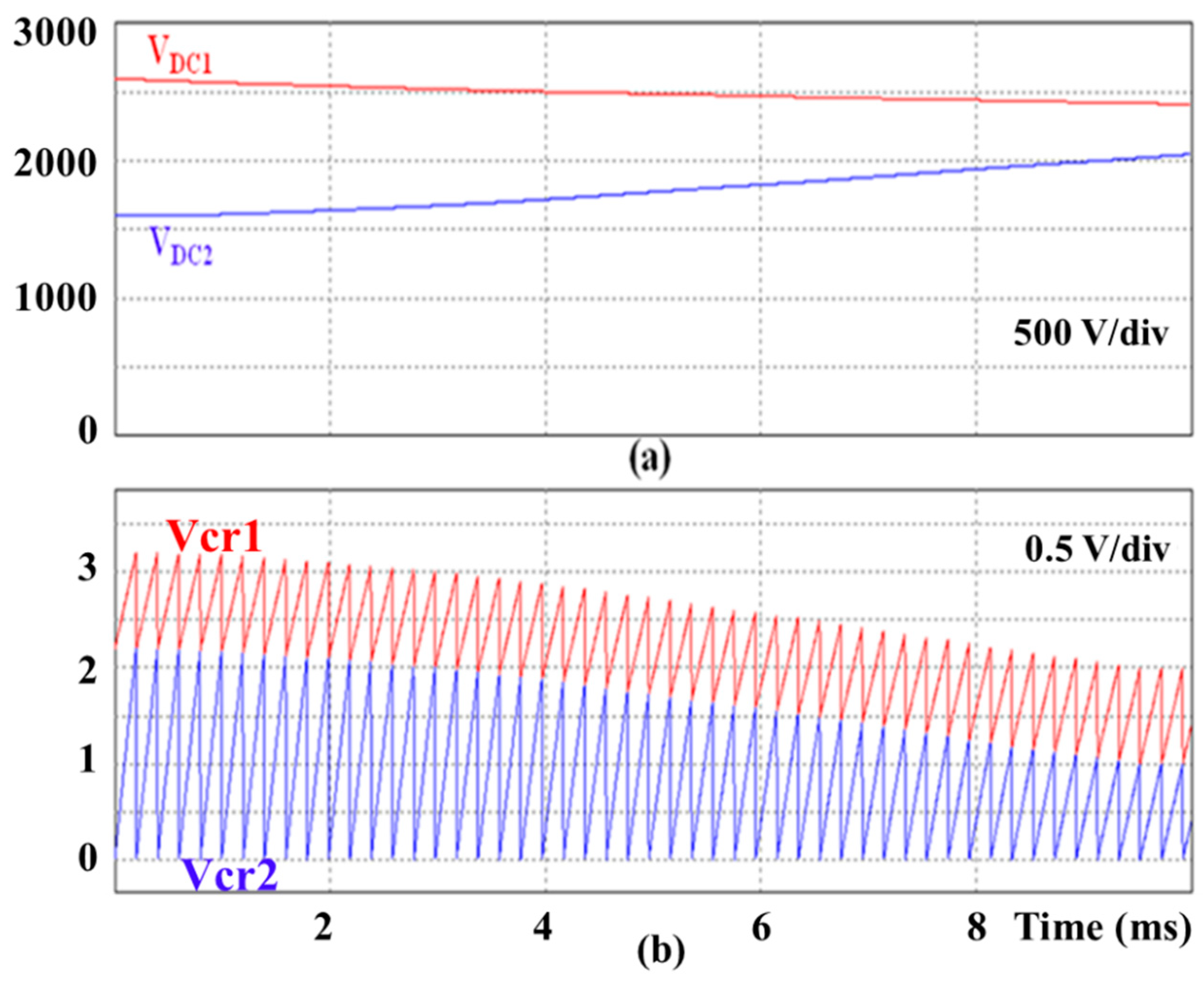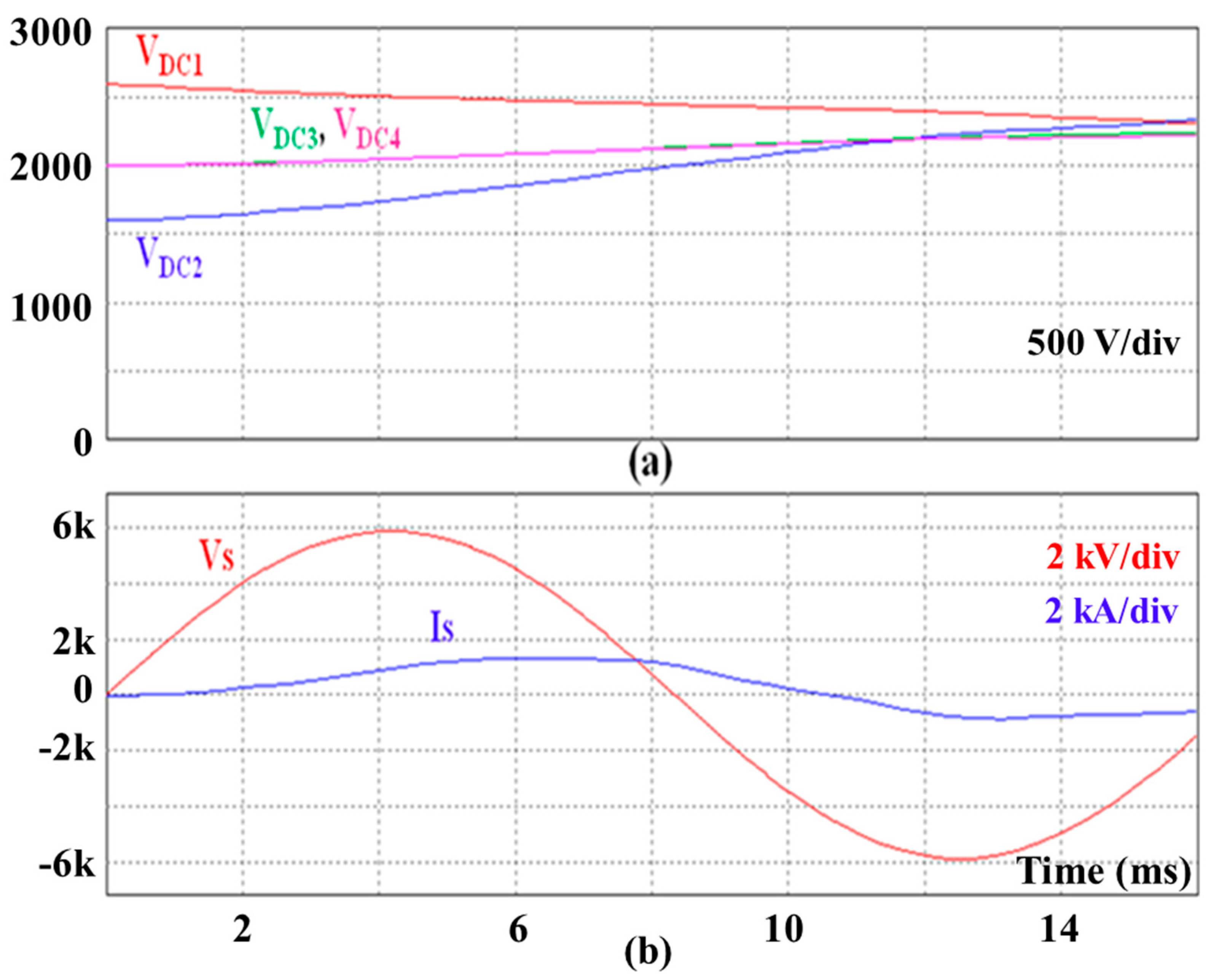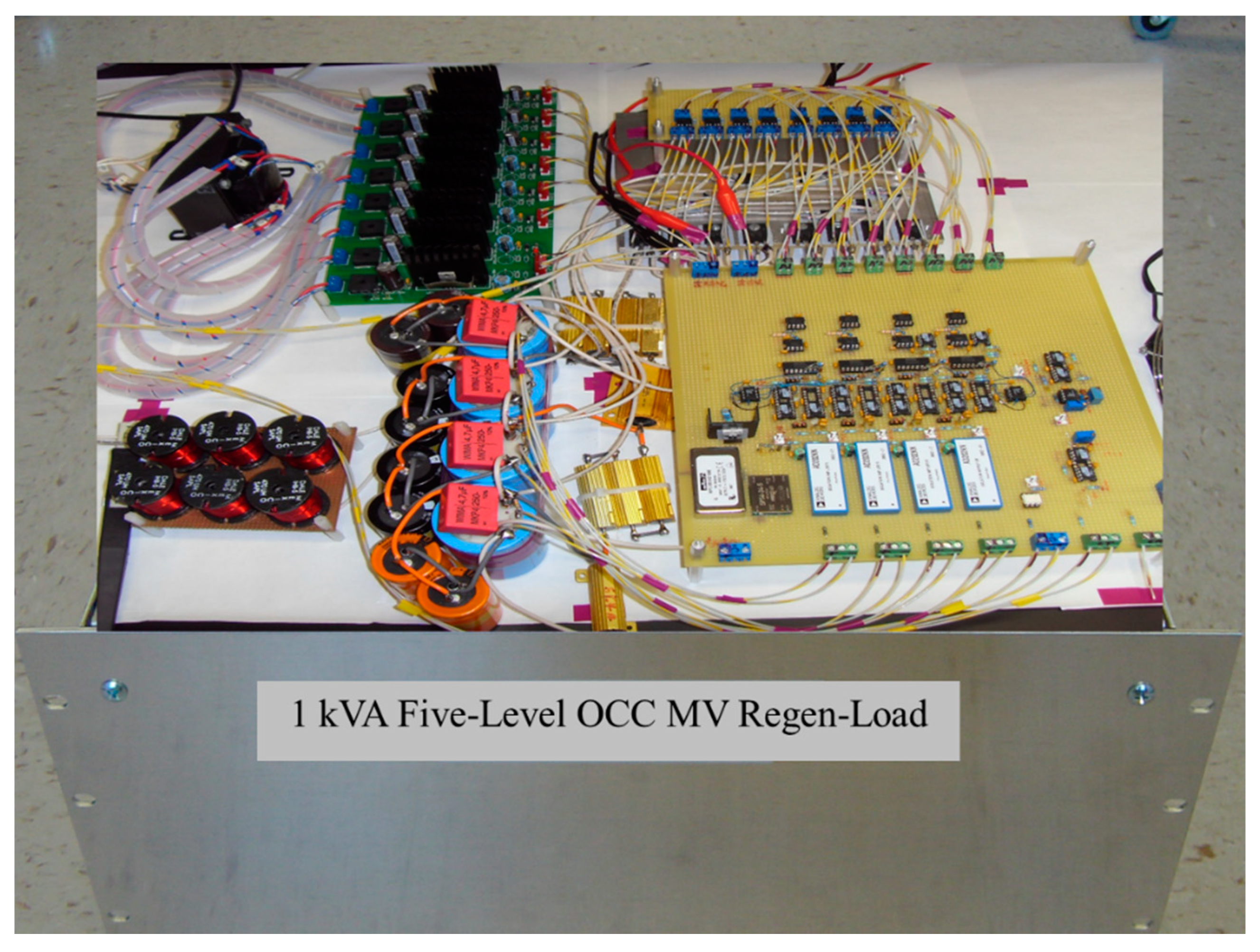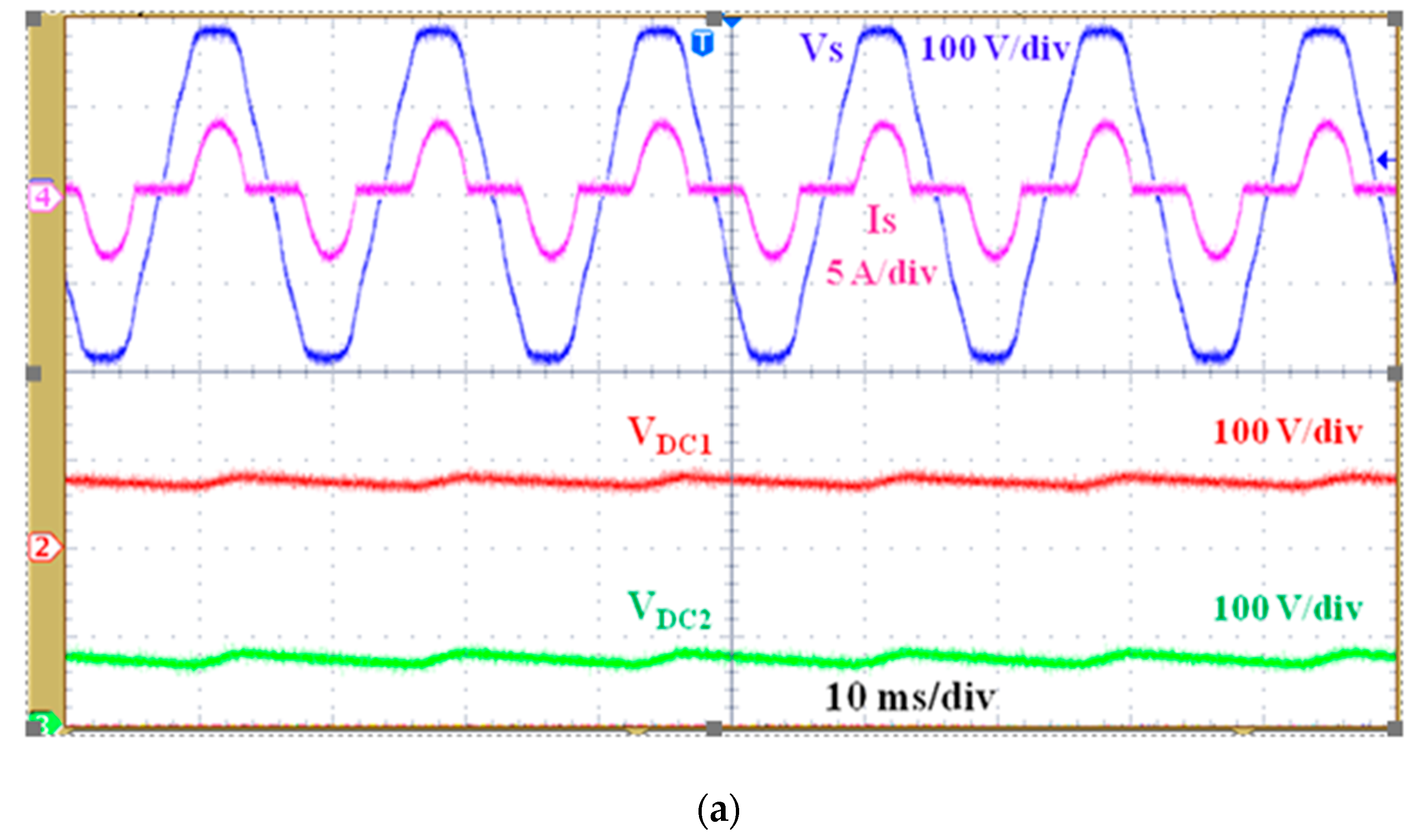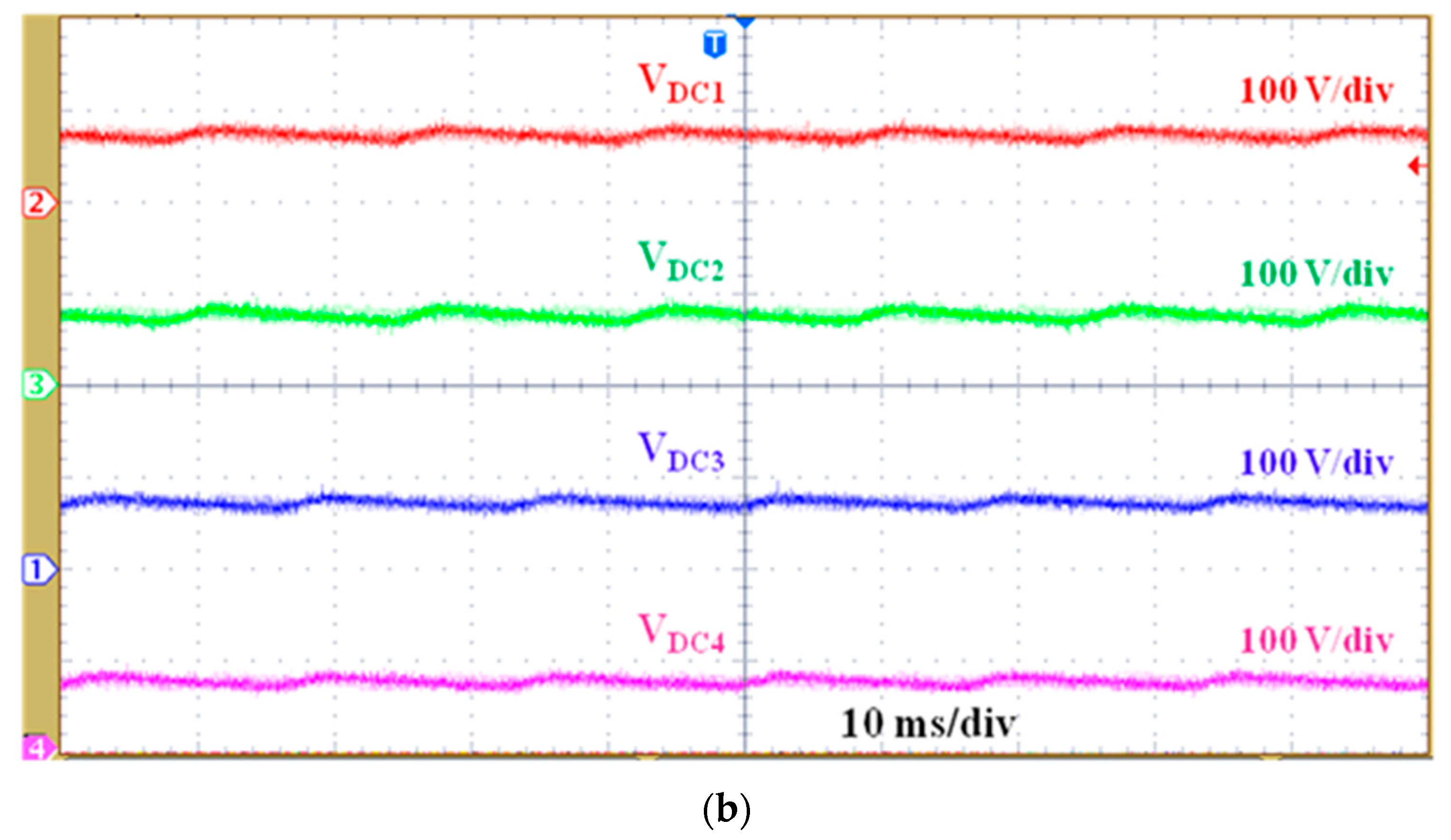1. Introduction
For utility companies the reliability of their power transmission and distribution equipment installed in the power grid is vital. The manufacturers of the high voltage power equipment can prove that their products have been tested according to international standards—IEC 62271, 61869, 60044 and 60076 standards, meet end-user specifications and relevant safety regulations. For this purpose, various loads are required to validate the performance, to carry on burn-in and to conduct lifetime testing of power conversion equipment, including uninterruptible power supplies, AC motors, turbine generators, inverters and power system equipment. Traditionally, high power load banks provide a practical solution for the manufacturers of the high-power equipment, but they are typically large, bulky and energy-consuming. Many load banks use a combination of resistors, inductors, capacitors and/or diode rectifiers to emulate various load conditions. When a different load parameter is required, reconnection of the load bank is necessary, which can be labor-intensive and time-consuming. This situation has led to the commercialization of some electronic loads that feature manual dial-in or automatic load adjustment, suitable for convenient and fast product testing. However, these electronic loads are limited in terms of both voltage and power rating. At present, these types of electronic loads are only available at low voltage, 400 V and low power level, 20 kVA per phase [
1].
For MV verification, the testing equipment is generally not regenerative and still burns 100% testing energy. Energy consumption for power equipment testing is a serious problem, especially for high power MV applications. To recycle the testing energy, high voltage multilevel power electronic converters with back-to-back structure play an essential role in high voltage and medium voltage (MV) power applications. For high power MV applications, three-level or five-level diode-clamped multilevel converters (DCMCs) have been widely adopted in high power back-to-back systems. To obtain sinusoidal waveforms and reduce harmonic components, five-level DCMC-based back-to-back configuration has been receiving more attention recently [
2]. However, the primary obstacle of the five-level DCMC-based back-to-back structure is control complexity to control 48 switching devices for the three-phase and achieve charge balance of four dc-link capacitors, for example, by using a modified space vector pulse width modulation (SVPWM) and a capacitor current prediction algorithm with or without an auxiliary hardware circuit that increases the complexity and the cost of the power conversion multilevel converters. There are commonly two types of the PWM methods to balance the dc-link capacitor voltages of the five-level DCMCs with or without back-to-back structure: (1) modified carrier-based SPWM [
2,
3,
4,
5] and (2) modified SVPWM [
6,
7,
8,
9,
10]. Generally, the carrier-based SPWM technique is much simpler than the SVPWM method. As far as the implementation of the SVPWM technique is concerned, it is computationally very difficult to realize.
In [
2], a MV adjustable-speed motor drive system based on two five-level DCMCs with back-to-back structure was proposed with 3 kHz four level-shifted carrier signals and four buck-boost choppers for achieving voltage balancing between four dc-link capacitors. The additional buck-boost choppers increase the complexity, the size and the cost of the proposed MV motor drive system. An auxiliary capacitor-based dc-link balancing approach was presented in [
3] to equalize the dc-link capacitor voltages of the five-level DCMC by utilizing the auxiliary capacitor as an equalizer between the capacitors of different voltages. The proposed balancing hardware circuit-based method can be applied to both the carrier-based SPWM and the SVPWM but requires additional circuits and control, which would increase hardware complexity and system failure. A new carrier-based SPWM method with voltage balancing capability was proposed for the five-level DCMCs with back-to-back structure in [
4]. For the back-to-back configuration, the unbalance tendencies of both sides (a rectifier and an inverter) have a potential to compensate each other because of the symmetry. By controlling proper offset voltages on both rectifier and inverter sides, the average current flowing into the inner junction can be adjusted to be equal to that flowing out from it. Then, the voltage balancing of the inner junction can be achieved. In addition, the switch angles cannot be directly controlled in the proposed SPWM control. Instead, the offset voltage of each inner junction should be calculated and added to the phase voltage reference, which is not the sinusoidal reference. Therefore, the proposed carrier-based SPWM method requires complicated calculation of all the switching angles and is only applicable when both modulation indexes of the rectifier and the inverter are less than 0.5. In [
5], a closed-loop dc-link voltage balancing algorithm was introduced with regular level-shifted carriers for a four-level DCMC. The proposed approach is based on redundant level modulation, which utilizes one additional voltage level in one switching cycle to obtain extra controllability of the dc-link capacitor voltages without distorting the fundamental frequency output voltage. However, the proposed dc-link voltage balancing method requires complicated control reference waveforms with the help of a digital signal processor (DSP) and makes additional switching transitions in one switching cycle, which increase the switching loss of the four-level DCMC.
A SVPWM-based switching strategy was proposed in [
6] for a five-level DCMC by using redundant switching vectors based on the minimum energy property of the balanced five-level DCMC. However, the proposed SVPWM method has limited operation under distorted ac current condition and only evaluated by MATLAB simulation without experimental verification. In [
7], a modified inner-hexagon-vector-decomposition-based space vector modulation method was introduced for a five-level DCMC in order to obtain the capacitor voltage balancing with high modulation index and high-power factor by introducing six new vector sequences to each triangle and applying a new vector selection rule. However, the proposed SVPWM method has two drawbacks in practice. First, the power factor is very small when the proposed five-level DCMC works as an active power filter, which brings little challenge to the voltage balancing control. Second, since an error exists between the reference vector and the actual synthesized vector, the magnitude and phase errors increase with the increasing dwelling time of transitional vectors. A new hybrid voltage balance method was proposed for five-level DCMCs in [
8], where additional flying-capacitor-based auxiliary circuits were used to balance the upper or lower two capacitors, along with a zero-sequence injection method to balance the midpoint voltage. Based on the proposed hybrid approach, the voltage stresses of power devices can be equalized, and the current ripples of the inductors can also be suppressed. However, the proposed hybrid voltage balance method requires the auxiliary circuits to balance the upper or lower two capacitors, which need two flying capacitors and inductors, and eight insulated gate bipolar transistors (IGBTs) with freewheeling diodes for each phase. The SVPWM-based switching strategy in [
6] was extended to a HVDC converter system in [
9] with back-to-back five-level DCMCs by using redundant switching vectors based on online minimization of the energy cost function, associated with the voltage deviations of the dc-link capacitors. The proposed SVPWM method was mostly evaluated by PSCAD/EMTDC time domain simulation with limited experimental verification, which was not enough to prove the proposed SVPWM and the energy cost function approach. In [
10], a SVPWM-based dc-link voltage strategy was proposed for five-level multipoint DCMCs with back-to-back configuration by using redundant switching vectors and reactive power exchange between the grid-side LCL filter and the front end five-level DCMC. Therefore, the proposed dc-link voltage balance is only guaranteed while the grid-side LCL filter is fully dimensioned to provide the 100% required reactive power of the front end five-level DCMC instead of 2–5% of the required reactive power. This is one of the disadvantages of the proposed SVPWM method with reactive power exchange.
Regenerative AC loads (Regen-Load) have been recently proposed to recycle the testing energy of the high voltage power equipment. Regen-Loads shall be capable of emulating various load conditions within the test ranges and recycling the testing energy back to the power grid. Relevant research on low voltage AC electronic loads was found based on standard H-bridge converters with state feedback control or state-space average model control using DSPs [
11,
12,
13], which require real time complicated calculation and some complex circuitry to implement the main controllers. Since the maximum blocking voltage of modern power semiconductor switches is about 6.5 kV, the H-bridge-based Regen-Loads are not ready to handle high power MV equipment testing. In this case, multilevel converter-based Regen-Loads will be necessary to overcome the voltage and current limits of the power semiconductor switches.
One-cycle control (OCC) technique has established a large-signal nonlinear PWM control method that features a simple circuit, high performance and universal applications. OCC has been successfully implemented in many sectors of power electronics including dc/dc converters, dc/ac inverters, power factor correction (PFC) rectifiers and active power filters (APFs) in both single-phase and three-phase configuration [
14,
15,
16,
17]. In [
14], a single-phase APF with OCC control was presented based on a full-bridge power converter under unipolar operation. The proposed OCC control method in [
14] can be only applicable for single-phase full-bridge type converters with the unity power factor. A three-phase PFC rectifier with OCC control was proposed based on a full-bridge power converter under vector operation. The proposed OCC method in [
15] was also applicable for only three-phase full-bridge type converters with the unity power factor. In [
16], a universal OCC vector controller was described for four-quadrant three-phase full-bridge type power converters, including PFC rectifiers and APFs. Finally, a first carrier level-shifted OCC PWM control method was proposed in [
17] for five-level DCMCs, but the dc-link capacitor voltage balancing theory was not presented in details.
This paper presents a five-level DCMC-based MV regenerative AC electronic load (MV Regen-Load) with four-carrier level-shifted OCC control based on back-to-back configuration targeted towards high power MV applications, with the capability of emulating various impedance loads. A small-scale prototype of 1 kVA 120 Vac five-level OCC MV Regen-Load was designed and tested to verify the performance of the proposed five-level OCC MV Regen-Load. The regenerative feature of the proposed MV Regen-Load provides an effective energy saving solution for MV power equipment testing since the testing energy is fed back to the grid instead of being dissipated as heat during operation. In this paper, especially the dc-link voltage balancing control of the proposed five-level MV Regen-Load by using the simple level-shifted OCC is deeply analyzed. Compared to the conventional level-shifted SPWM control, the proposed level-shifted OCC of the five-level DCMC-based MV Regen-Load has the variable amplitudes of four carrier signals instead of the fixed amplitudes. With variable amplitude control of the four carrier signals, the dc-link capacitor voltages automatically become balanced and equal to the reference voltage (VDC/4). The most important merit of the proposed multilevel OCC method is to reduce a heavy computing burden. Simulation and experiments were performed using small-scale five-level DCMCs to verify the proposed multilevel MV Regen-Load performance.
3. OCC Control of Five-Level Regen-Load
As shown in
Figure 2, the five-level DCMC is comprised of eight active switches (
SA1–
SA’4), 12 clamping diodes, four dc-link capacitors and an input inductor (
LS). Voltage sharing between the main switches is achieved by the clamping diodes. It has been a major challenge to balance the dc-link capacitor voltages in a multilevel converter, especially as the number of levels increases. Traditionally two types of balancing methods were reported: using the redundant switching states and using the auxiliary balancing circuits.
With the SVPWM control, a number of redundant switching states can be used to help balance the dc-link capacitor voltages. This approach may minimize or eliminate the need for auxiliary balancing circuits. However, for five or higher-level multilevel converters, the SVPWM control is computation intensive and not commonly used in industrial applications. For example, a five-level multilevel converter has 53 = 125 switching states, for which the computation burden may require high-speed DSPs, limit the maximum switching frequency or slow down control response. In addition, the use of redundant switching states increases the switching frequency and the switching loss which is undesired for practical applications.
On the other hand, the traditional carrier-based SPWM control of the DCMCs produces unbalanced dc-link capacitor voltages. Thus, a balancing circuit is generally required, which significantly increases the complexity of the multilevel converter circuits or systems.
The proposed level-shifted OCC method provides a simple approach to balance the dc-link capacitor voltages for multilevel converters without involving any auxiliary balancing circuit. For the five-level DCMC, four-carrier level-shifted SPWM with variable carrier-amplitude control is employed as shown in
Figure 3a. In general, the four carriers can be arranged in different forms: phase disposition (PD), phase opposition disposition (POD) and alternative phase opposition disposition (APOD). Among the above carrier forms, the PD technique, where all carriers are in phase, provides the lowest harmonic distortion.
Based on the level-shifted PD SPWM control, the four carrier signals (Vcr1–Vcr4) of the proposed five-level OCC MV Regen-Load have the same phase but different amplitudes, depending on each dc-link capacitor voltage (VDC1, … VDC4).
Figure 3 shows the single-phase OCC MV Regen-Load PWM waveforms of the five-level DCMC input rectifier. In
Figure 3a, a sinusoidal reference (
RS·
IS +
VIref) is compared with the four carrier signals (
Vcr1–
Vcr4) to determine the switched voltage levels: +
VDC/2 (+
VDC1 +
VDC2), +
VDC/4 (+
VDC2), 0, −
VDC/4 (−
VDC3) and −
VDC/2 (−
VDC3 −
VDC4). The line period is divided into four operation regions, according to where the reference signal lands, named as I, II, III and IV. The five-level DCMC input rectifier assumes different equivalent circuits and switching states in a different operation region.
Table 1 shows the five-level DCMC input rectifier voltages (
Vrec or
Vrec–N) and their switching states. The eight active switches are controlled as complementary pairs (
SA1,
SA’1, etc.). In region I in
Figure 3a, the input rectifier voltage is switched between
VDC1 +
VDC2 and
VDC2 by the first upper switch
SA1 and its complementary switch
SA’1. As shown in
Figure 3b, the other upper switches (
SA2–
SA4) are kept on in region I. Similarly, in region II, the second upper switch
SA2 and its complementary switch
SA’2 are switched to provide the input rectifier voltage between
VDC2 and 0. In this region, the first upper switch
SA1 is turned off, and the other two upper switches (
SA3,
SA4) are always turned on to provide the neutral point connection (0 or
N) in
Figure 2. For region III and IV, the same switching approach is applied to produce the negative input rectifier voltages.
Assuming that the proposed OCC MV Regen-Load operates in continuous conduction mode, the equivalent circuits and the OCC control equations can be found for four operation regions.
Figure 4 shows the simplified equivalent circuit of the five-level OCC MV Regen-Load in region I. By applying the volt-second balance rule to the input inductor (
LS), the conversion gain equation for the equivalent circuit in
Figure 4 can be derived by (1):
where
dSA1 is the duty ratio of the first upper switch
SA1.
Then, the control goal of the OCC MV Regen-Load is for the input current (
iS) to track the current reference signal (
VIref). According to this condition, the control goal can be defined by the Norton equivalent circuit as follows:
where
RE is the emulated resistance of the input rectifier and
ISref is the input current reference.
By combining the conversion gain Equation (1) and the control goal (2), the control key equation for the OCC MV Regen-Load in region I can be derived by the Thévenin equivalent circuit as follows:
where
RS is the sensing resistance of the input current,
VIref is the current reference signal,
Vm1–
Vm2 are the carrier amplitudes,
,
and
.
With a similar procedure, the control key equations for the other operation regions can be derived in
Table 2.
To implement all the control key equations, an OCC level-shifted PWM control circuit is proposed shown in
Figure 5, using a clock signal (CLK), four integrators, four comparators, four RS flip-flops and four reset switches for PWM generation. The OCC level-shifted PWM control circuit of the five-level OCC MV Regen-Load consists of four voltage compensators and OCC level-shifted PWM generators for the eight gate signals (
SA1–
SA’4). The four identical voltage compensators determine the carrier amplitudes (
Vm1–
Vm4), depending on deviation of each dc-link capacitor voltage (
VDC1–
VDC4) from the reference voltage
V*DC (=
VDC/4). Using four integrators and three adders, the level-shifted carrier signals (
Vcr1–
Vcr4) are generated with the different amplitudes and dc-level shifts. By comparing the control reference (
RS·
IS +
VIref) with the four carrier signals (
Vcr1–
Vcr4), the actual gate signals are produced by the RS flip-flops. When both the input signals of each comparator approach one another, the comparator changes its state, which in turn resets the RS flip-flop through its ‘
R’ input terminal and its integrator to zero. The next clock signal (CLK) sets the RS flip-flop through its ‘
S’ input terminal and the output terminal ‘
Q’ of the RS flip-flop is also set, which turns on its gate signal (
SA1–
SA4). With variable amplitude control of the four carrier signals, the dc-link capacitor voltages can become balanced and equal to the reference voltage (
VDC/4) even under different dc-link capacitances (
C1–
C4).
The input current of the five-level DCMC input rectifier of the OCC MV Regen-Load accurately tracks the current reference signal and to realize the specified impedance load. For the proposed OCC MV Regen-Load, the control of the input rectifier is the key point. For the five-level DCMC output inverter of the OCC MV Regen-Load, the control goal is to make the output current IO of the OCC MV Regen-Load synchronous with the grid voltage VO and contribute to the unit power factor injection of the recycled testing energy with the highest efficiency. In this condition, the control requirement is to realize unit power factor operation and stabilize the dc-link voltage. A multilevel converter similar to the input rectifier can be used to implement the inverter. Due to the similarity of the topology and for the purpose of simplicity but without loss of the generality, the discussion of the multilevel inverter is kept brief.
4. DC-Link Capacitor Voltage Balance Analysis
For the DCMCs, a major challenge is to keep all dc-link capacitor voltages balanced, which was usually achieved with an extra voltage-balancing circuitry or a specific voltage-balancing control previously.
In this section, the dc-link capacitor voltage balance issue for the five-level OCC MV Regen-Load is analyzed based on the proposed level-shifted OCC control.
Figure 6 shows the dc-link currents of the five-level OCC MV Regen-Load in region I and II when the control reference (
RS·
IS +
VIref) is positive during the half-cycle of the input line frequency. In region I and II, the two upper switches (
SA1,
SA2) are modulated, respectively, and the two upper dc-link capacitors (
C1,
C2) are also charged or discharged, respectively, depending on the load emulation and each dc-link capacitor voltage. When the control reference is negative in region III and IV, the other upper two switches (
SA3,
SA4) are switched, respectively, with the two lower dc-link capacitors (
C3,
C4), and the related PWM control and the dc-link voltage-balancing method in region III and IV are the same as those in region I and II. For proper operation of the five-level OCC MV Regen-Load, the amplitudes and dc-level shifts of the four carrier signals (
Vcr1–
Vcr4) must be properly controlled to achieve dc-link voltage balancing.
Figure 7 shows the simplified equivalent circuit models of the five-level OCC MV Regen-Load in region I and II, respectively. From
Figure 7a, the two dc-link capacitor currents (
iC1,
iC2) in region I can be described by the following expressions:
Similarly, the two dc-link capacitor currents in region II, which are shown in
Figure 7b can be expressed as:
Assuming that the four dc-link capacitors (
C1–
C4) have the same capacitance, when a disturbance causes imbalance in the two upper dc-link capacitor voltages (e.g.,
VDC1 >
V*DC >
VDC2), a state variable ∆
V is defined as half the difference between the two upper dc-link capacitor voltages (
VDC1,
VDC2), which should converge to zero with the proposed level-shifted OCC control. In the unbalanced condition, each dc-link capacitor voltage can be defined as a function of the voltage difference ∆
V by:
where
In order to maintain the dc-link capacitor voltage balance, the proposed control of the five-level OCC MV Regen-Load in region I and II is shown in
Figure 8. From
Figure 8a, the duty ratios of the
SA1 switch under an unbalanced dc-link condition can be described as follows:
where
dSA1(n) and
dSA1(n + 1) are the duty ratios of the
SA1 switch at the (
n)th and (
n + 1)th switching cycles, and:
From (8) and (9), the duty ratio variation of the
SA1 switch (∆
dSA1) to compensate the unbalanced dc-link capacitor voltages can be obtained by:
Assuming
VDC1(n) >> ∆
VDC1(n), the above equation can be simplified as:
From (4) and (11), it is possible to define the relationship between the duty ratio variation of the
Vcr1 carrier signal and the compensation for the dc-link capacitor voltage unbalance. The voltage variations of the two upper dc-link capacitors (
C1,
C2) in region I are given by:
When VDC1 > V*DC > VDC2, ∆dSA1 is negative and ∆IINV1 is positive in region I. Therefore, the over-charged C1 capacitor voltage (VDC1) will decrease and the under-charged or over-discharged C2 capacitor voltage (VDC2) will increase to reduce the dc-link capacitor voltage deviation, depending on the difference between ∆IINV1 and ∆IINV2.
Since ∆
VDC1(n) – ∆
VDC1(n + 1) = (1 –
A1) · ∆
VDC1(n) −
A2·∆
VDC2(n) −
AC1 −
AC2 > 0, the following compensation control is obtained:
In this unbalanced condition, ∆
VDC1 is decreasing during each switching cycle to reach the nominal dc-link capacitor voltage. From
Figure 8b, similarly, the duty ratios of the
SA2 switch under an unbalanced dc-link condition can be described as follows:
where
dSA2(n) and
dSA2(n + 1) are the duty ratios of the
SA2 switch at the (
n)th and (
n + 1)th switching cycles, and:
From (14) and (15), the duty ratio variation of the
SA2 switch (∆
dSA2) to adjust the unbalanced dc-link capacitor voltages can be obtained by:
Assuming
VDC2(n) >> ∆
VDC2(n), the duty ratio variation of the
SA2 switch can be simplified as:
From (5) and (17), the voltage variations of the two upper dc-link capacitors (
C1,
C2) in region II are given by:
When VDC1 > V*DC > VDC2, ∆dSA2 is positive and ∆IINV1 is also positive in region II, the over-charged C1 capacitor voltage (VDC1) will decrease and the under-charged C2 capacitor voltage (VDC2) will increase to eliminate the dc-link capacitor voltage deviation.
Finally, the voltage variations of the four dc-link capacitors (C1–C4) can be described as follows:
Using (19), the voltage variation vector Δ
VDC(n) can be written by a 4 × 4 matrix
A and the initial voltage variation vector Δ
VDC(0):
where:
From (19)–(21), it is clear that the voltage variations of the four dc-link capacitors become zero in steady state, even though there are some voltage variations of the dc-link capacitors in the beginning or induced by some perturbation. Based on the proposed level-shifted OCC control, dc-link capacitor voltage balance can be achieved for any load emulation condition. It is also clear that the stabilizing time required to eliminate the dc-link voltage unbalance is proportional to the dc-link capacitance and inversely proportional to the amplitude of the input current.
